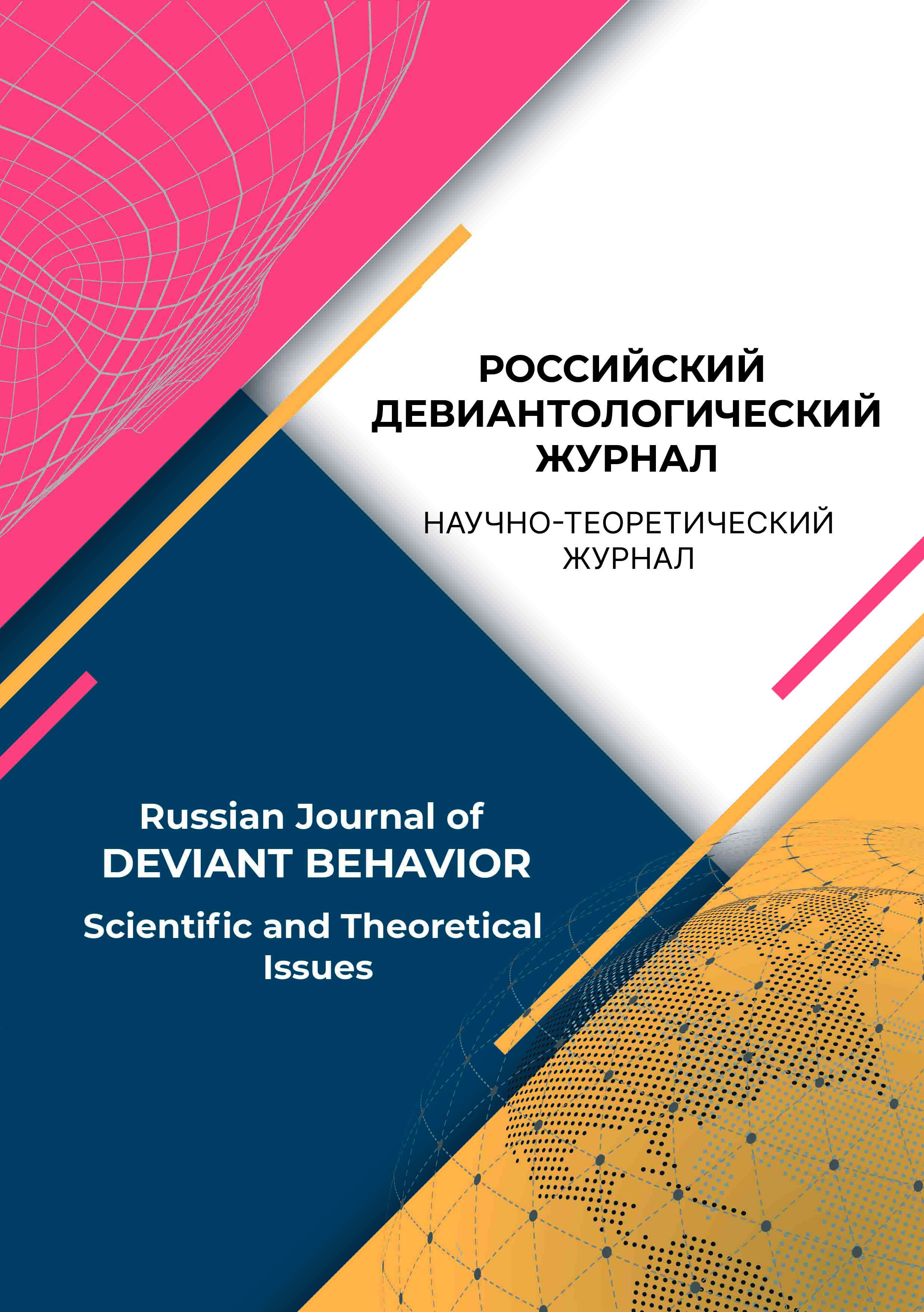Russian Federation
Sankt-Peterburg, Russian Federation
CSCSTI 15.81
Russian Classification of Professions by Education 37.06.01
Russian Library and Bibliographic Classification 884
Russian Trade and Bibliographic Classification 8334
BISAC PSY014000 Forensic Psychology
Introduction. The relevance of the research problem is confirmed by statistics on juvenile delinquency, as well as by legal acts. The problem of predicting the deviant behavior of juvenile offenders is reviewed through description of static and dynamic risk factors for repeated offenses. One of the findings of the study is that it is the personal features that determine deviant behavior, whereas the situational factors play the role of modulators. A review of the literature sources allows us to conclude that personality traits are related to criminal behavior, which makes it possible to predict the deviant behavior of juvenile offenders. Aim of the study is to identify the personal characteristics that determine the deviant behavior of juvenile offenders. Methodology, methods and techniques. The methodological basis of the research is a dispositional approach to the study of personality, which assumes their readiness for a certain behavior, repeated in various situations, formed as a result of the interaction of objective and subjective factors. Research methods: The following methods were used to conduct the study: the personal questionnaire of G. Eysenck EPQ; the questionnaire of the level of aggressiveness of A. Bass and A. Darkee; the individual typological questionnaire of L. N. Sobchik (ITQ); the personal questionnaire «Mini-cartoon» (abbreviated version of MMPI) in the adaptation of F. B. Berezin and M. P. Miroshnikov; the Freiburg multifactorial personality questionnaire FPI (form B). Findings of the study: A comparative analysis of the individual psychological characteristics of juvenile offenders and participants of the control group with normative behavior showed multiple statistically significant differences in assessments for 36 variables out of 55 (65.5 %). Discriminant analysis allowed us to determine 8 common features of “deviance-law-abidance”: aggression, hostility, irritability, guilt, psychopathy, neuroticism, introversion, open attitude. They act as prognostic criteria for deviant behavior of adolescents and discriminate against subjects with a prediction accuracy of 97%. Scientific novelty of the research consists in enhancing and clarifying awareness of personality traits of deviant adolescents who have committed crimes, as well as predicting deviant behavior. Practical significance: The patterns and recommendations obtained can be useful in preventive, educational, correctional work, and family counseling. The identified personality traits of deviant behavior can be used as prognostic criteria for identifying deviations at the early stages of socialization of children and adolescents.
predicting deviant behavior, determinants, juvenile offenders, individual psychological characteristics
1. Brian, J. S., Swagar N. (2021). The Role of Neighborhood Context in the Relationship between Parenting Effectiveness and Self-control. Crime & Delinquency, 67(10), 1459-1490. https://doi.org/10.1177/0011128720951436
2. Chu, C. M., Yu, H., Lee, Y. (2014). The Utility of the YLS/CMI-SV for assessing youth offenders in Singapore. Criminal Justice and Behavior, 41(12), 1437-1457. DOI:https://doi.org/10.1177/0093854814537626
3. Duin, L. V., Robbé, M. De V., Marhe, R. et. al. (2021). Criminal history and adverse childhood experiences in relation to recidivism and social functioning in multi-problem young adults. Criminal justice and behavior. 48(5), 637-654. DOI: https://doi.org/10.1177/0093854820975455
4. Hare, R. D. (2003). PCL-R Technical Manual (2nd edn). Toronto: Multy-Health Sistems.
5. Heaven, P. (1996). Personality and self-reported delinquency: Analysis of the «Big Five» personality dimensions. Personality and Individual Differences, 20(1), 47-54.
6. Hoge, R. D., Andrews, D. A. (2002). Youth Level of Service. Toronto: Multi Health Services.
7. Hill, J. M., Blokland, A. J., van der Geest V. R., (2018). Risk factors for self-reported delinquency in emerging adulthood. European journal of criminology, 15(5), 544-566.
8. Hirschi, T., (1969). Causes of Delinquency. Berkeley: University of California Press.
9. Matz, A. K., Martinez A. R., Kujava E. (2020). Assessing Risk in North Dakota Juvenile Probation: A Preliminary Examination of the Predictive Validity of the Youth Assessment and Screening Instrument, 67(4), 551-573. https://doi.org/10.1177/0011128720950023
10. McCrae, R. R., Costa, P. T. (2006). Personality in adulthood: a five-factor theory perspective. New York: The Guilford Press.
11. Mendoza, N. S., Rose, R. A., Geiger, J. M., Cash MSSW, S. J., (2016). Risk assessment with actuarial and clinical methods: Measurement and evidence-based practice. Child Abuse & Neglect, 61, 1-12. https://doi.org/10.1016/ j.chiabu.2016.09.004
12. Mededovic, J. (2017). The profile of a criminal offender depicted by HEXACO personality traits. Personality and Individual Differences, 107, 159-163.
13. Oleson, J. C., VanBenschoten, S. W., Robinson, C. R., & Lowenkamp, C. T. (2011). Training to see risk: Measuring the accuracy of clinical and actuarial risk assessments among federal probation officers. Federal Probation, 75(2), 52-56.
14. Powell, Z. A., Craig, J. M., Piquero, A. R., Baglivio, M. T., & Epps, N. (2019). Delinquent Youth Concentration and Juvenile Recidivism. Deviant Behavior, 42(7), 807-820. https://doi.org/10.1080/01639625.2019.1701622
15. Thompson-Dyck, K. (2021). Neighborhood Context and Juvenile Recidivism: A Spatial Analysis of Organizations and Reoffending Risk. Crime & Delinquency. https://doi.org/10.1177/0011128721999336
16. Stallings, M., Hewitt, J., Cloninger, R., Heath, A. (1996). Genetic and environmental structure of the tridimensional personality questionnaire: three or four temperament dimensions? Journal of Personality and social psychology, 70, 127-140.
17. Steadman, H. J., Monahan, J., Robbins, P. et al. (1993). From dangerousness to risk assessment: Implications for appropriate research strategies. In S. Hodgins (ed.), Crime and Mental Disorder. Newbary Park, CA: Sage.
18. Walters, G. D. (2020). Parental Control as a Stimulus for Youth Control: Mediating the Parental Knowledge - Child Delinquency Relationship With Cognitive Impulsivity. Crime & Delinquency, 67(5), 717-736. https://doi. org/10.1177/0011128720962449
19. Arzumanyan, S. D. (1989). Izuchenie kriminogennyh ustanovok u nesovershennoletnih s otklonyayushchimsya povedeniem. V A.R. Ratinov i dr. (red.), YUridicheskaya psihologiya: tezisy dokladov k VII s”ezdu obshchestva psihologov SSSR (Str. 3-4). Moskow: Izd-vo Akademii nauk SSSR.
20. Afanas’eva, O. R., Gleba, O. V. (2017). Kriminologicheskoe prognozirovanie individual’nogo prestupnogo povedeniya. Mezhdunarodnyj nauchno-issledovatel’skij zhurnal, 3(57) CH. 2, 118-122. DOI: https://doi.org/10.23670/ IRJ.2017.57.109
21. Bochkareva, G. G. (1968). Psihologicheskaya harakteristika motivacionnoj sfery podrostkov-pravonarushitelej: avtoref. dis. … kand. ped. nauk po psihologii. Moskow.
22. Valickes, G. V. (1987). Samoocenka u nesovershennoletnih pravonarushitelej: ee formirovanie i rol’ v povedenii: avtoref. dis. … kand. psihol. nauk. Moskow.
23. Velev, V. P. (2012). Osobennosti samosoznaniya i povedeniya deviantnyh podrostkov: dis. … kand. psihol. nauk. Moskow.
24. Goncharova, N. A. (2006). Cennostnye determinanty lichnosti nesovershennoletnih pravonarushitelej: avtoref. dis. … kand. psihol. nauk. Saint Petersburg.
25. Il’yankova, E. I., Semakova, A. I. (2021). Optimizaciya psihologicheskogo blagopoluchiya nesovershennoletnih s delinkventnym povedeniem. Rossijskij deviantologicheskij zhurnal, 1(1), 84-98. doi:https://doi.org/10.35750/2713-0622-2021- 1-84-98
26. Kobozev, I. YU. (2018). Transdiskursivnaya psihologiya v kontekste stanovleniya prognosticheskoj teorii v organah vnu¬trennih del. V YU.A. SHaranov, V.A. SHapoval (red.), Aktual’nye problemy psihologii pravoohranitel’noj deyatel’nosti: koncepcii, podhody, tekhnologii (Vasil’evskie chteniya-2018): materialy mezhdunarodnoj nauchno-prakticheskoj konferencii (Str. 207-212). Saint Petersburg: Sankt-Peterburgskij universitet MVD Rossii.
27. Kirillova, E. B. (2019). Lichnostnye psihologicheskie determinanty predraspolozhennosti podrostkov k deviantnomu povedeniyu: dis. … kand. psihol. nauk. Saint Petersburg.
28. Kurbatova, T. N. (1995). Sravnitel’nyj analiz psihologicheskih osobennostej nesovershennoletnih pravonarushitelej. Eks¬perimental’naya i prikladnaya psihologiya, 14, 119-123.
29. Pastushenya, A. N. (2000). Kriminogennaya sushchnost’ lichnosti prestupnika: psihologicheskij aspekt: dis. … d-ra. psihol. nauk. Moskow.
30. Adamchuk, D. V., Rean, A. A. (red.) (2016). Psihologiya deviantnosti. Deti. Obshchestvo. Zakon: monografiya. YUniti.
31. Rean, A. A. (2015). Faktory riska deviantnogo povedeniya: semejnyj kontekst. Nacional’nyj psihologicheskij zhurnal, 4(20), 105-110.
32. Chirkina, R. V., Delibalt, V. V., Dozorceva, E. G. i dr. (2018). K voprosu obosnovaniya diagnosticheskih priznakov razlichnyh kategorij nesovershennoletnih s protivopravnym povedeniem v kontekste deyatel’nosti PMPK. Psihologiya i pravo, 8(1), 77-94. doi:https://doi.org/10.17759/psylaw.2018080106
33. Chirkina, R. V. (2008). Izmenenie ustanovok protivopravnogo povedeniya lichnosti u nesovershennoletnih: dis. … kand. psihol. nauk. Moskow.
34. Yadov, V. A. (2013). Samoregulyaciya i prognozirovanie social’nogo povedeniya lichnosti: dispozicionnaya koncepciya (2-e rasshir. izd.) Moskow: CSPiM.














